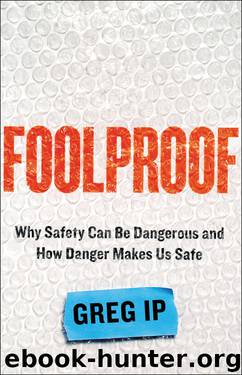Foolproof by Greg Ip

Author:Greg Ip [Ip, Greg]
Language: eng
Format: epub
Publisher: Little, Brown and Company
Published: 2015-10-13T05:00:00+00:00
The less familiar an activity or threat and the more dread it inspires, the greater the risk it is perceived to be. (Source: data provided by Paul Slovic)
Although hundreds died during the evacuation following the Fukushima nuclear accident and the tsunami that caused the accident, the power plant meltdown itself has not yet been implicated in any deaths. Compare that to the litany of deaths in recent years from conventional energy sources: eleven when the Deepwater Horizon drilling rig exploded in the Gulf of Mexico; twenty-nine miners in the Big Branch coal mine explosion in 2010; eight in a natural gas pipeline explosion in San Bruno, California, in 2010; six when a gas-fired power plant exploded in Middletown, Connecticut, in 2010; forty-seven in the town of Lac-Mégantic, Quebec, when a train carrying seventy-two tank cars of crude oil crashed and set the town’s center on fire.
That’s only the direct toll from accidents. Far more people die indirectly, for example from pollution or radiation exposure. Researchers from Stanford University reckon that 130 people will die due to cancer caused by radiation released in the Fukushima disaster (that’s their best guess in a very wide range of 15 to 1,300). The final death toll from the Chernobyl disaster by one estimate could reach 4,000 (other estimates reach 93,000), though as of 2006, only 47 deaths were conclusively linked to its radiation. Yet these figures, too, pale in comparison to the deaths attributed mainly to the pollution belched into the air each year by wood, oil, gas, and coal: more than 7,000 in the United States alone, and potentially millions worldwide.
In the wake of Three Mile Island, American regulators began cracking down on safety violations at power plants, and in 1985 the Tennessee Valley Authority, a federally operated electric utility serving the South, temporarily shut down several nuclear reactors. Edson Severnini at Carnegie Mellon University found that as a result, electricity generation from coal-fired plants operated by the TVA rose, and those plants’ counties experienced more pollution and more babies with lower birth weight.
Former NASA scientist James E. Hansen, one of the loudest voices in the scientific community warning of global warming, and his colleague Pushker A. Kharecha have tried to quantify the relationship between nuclear power and mortality. They figured that between 1971 and 2009, the use of nuclear power had prevented 1.84 million deaths by avoiding the burning of coal and natural gas and the resulting air pollution. In Germany, the figure was 117,000. They then asked how many deaths would be prevented if nuclear power were not phased out. They concluded that between 2010 and 2050, if nuclear power replaced natural gas, 420,000 to 680,000 deaths would be avoided. If it replaced coal, the number of lives saved rises to between 4.4 million and 7 million. These numbers don’t reflect any additional harm from climate change such as heat waves, floods, droughts, and food shortages. Without nuclear power, it would be far harder to hold carbon emissions to what they consider a safe level.
Download
This site does not store any files on its server. We only index and link to content provided by other sites. Please contact the content providers to delete copyright contents if any and email us, we'll remove relevant links or contents immediately.
International Integration of the Brazilian Economy by Elias C. Grivoyannis(99347)
The Radium Girls by Kate Moore(11978)
Turbulence by E. J. Noyes(7983)
Nudge - Improving Decisions about Health, Wealth, and Happiness by Thaler Sunstein(7662)
The Black Swan by Nassim Nicholas Taleb(7064)
Rich Dad Poor Dad by Robert T. Kiyosaki(6517)
Pioneering Portfolio Management by David F. Swensen(6261)
Man-made Catastrophes and Risk Information Concealment by Dmitry Chernov & Didier Sornette(5958)
Zero to One by Peter Thiel(5736)
Secrecy World by Jake Bernstein(4703)
Millionaire: The Philanderer, Gambler, and Duelist Who Invented Modern Finance by Janet Gleeson(4425)
The Age of Surveillance Capitalism by Shoshana Zuboff(4252)
Skin in the Game by Nassim Nicholas Taleb(4206)
Bullshit Jobs by David Graeber(4143)
The Money Culture by Michael Lewis(4138)
Skin in the Game: Hidden Asymmetries in Daily Life by Nassim Nicholas Taleb(3962)
The Dhandho Investor by Mohnish Pabrai(3729)
The Wisdom of Finance by Mihir Desai(3698)
Blockchain Basics by Daniel Drescher(3544)
